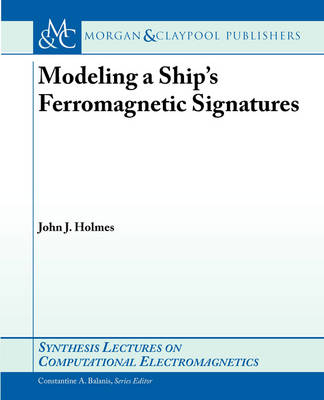
Modeling a Ship’s Ferromagnetic Signatures
Seiten
2007
Morgan & Claypool Publishers (Verlag)
978-1-59829-250-3 (ISBN)
Morgan & Claypool Publishers (Verlag)
978-1-59829-250-3 (ISBN)
- Lieferbar
- Versandkostenfrei
- Auch auf Rechnung
- Artikel merken
Presenting the mathematical basis of generalized coordinate systems, this book demonstrates with example applications to analytic spherical and prolate spheroidal magnetic ship models. It also presents extrapolation of measured magnetic signatures from testing environments to threat areas using semi-empirical math models.
Ferromagnetic models of ships and submarines that predict or reproduce their magnetic signatures have found applications in the development of both offensive and defensive military systems from World War II to the present. The mathematical basis of generalized coordinate systems will be presented and demonstrated with example applications to analytic spherical and prolate spheroidal magnetic ship models. In addition, the advantages and pitfalls of using complex finite-element- and boundary-element numerical techniques to predict high-order near-field ship signatures will be discussed, followed by a short description of the design and testing of complementary physical scale models. Extrapolation of measured magnetic signatures from testing environments to threat areas using semi-empirical math models will be presented, along with an explanation of their inherent instabilities and methods for regularizing them. These magnetic ship signature modeling techniques are used today in designing optimized signature reduction systems that have a minimum impact on ships and their systems. The discussion will be closed with an important discussion of the verification and validation of magnetic models of surface ships and submarines.
Ferromagnetic models of ships and submarines that predict or reproduce their magnetic signatures have found applications in the development of both offensive and defensive military systems from World War II to the present. The mathematical basis of generalized coordinate systems will be presented and demonstrated with example applications to analytic spherical and prolate spheroidal magnetic ship models. In addition, the advantages and pitfalls of using complex finite-element- and boundary-element numerical techniques to predict high-order near-field ship signatures will be discussed, followed by a short description of the design and testing of complementary physical scale models. Extrapolation of measured magnetic signatures from testing environments to threat areas using semi-empirical math models will be presented, along with an explanation of their inherent instabilities and methods for regularizing them. These magnetic ship signature modeling techniques are used today in designing optimized signature reduction systems that have a minimum impact on ships and their systems. The discussion will be closed with an important discussion of the verification and validation of magnetic models of surface ships and submarines.
Introduction
Basic Equations
First-Principal Models
Semiempirical Models
Summary
| Erscheint lt. Verlag | 30.7.2007 |
|---|---|
| Reihe/Serie | Synthesis Lectures on Computational Electromagnetics |
| Verlagsort | San Rafael |
| Sprache | englisch |
| Maße | 187 x 235 mm |
| Themenwelt | Mathematik / Informatik ► Mathematik ► Angewandte Mathematik |
| Naturwissenschaften ► Physik / Astronomie ► Elektrodynamik | |
| Technik ► Fahrzeugbau / Schiffbau | |
| ISBN-10 | 1-59829-250-1 / 1598292501 |
| ISBN-13 | 978-1-59829-250-3 / 9781598292503 |
| Zustand | Neuware |
| Haben Sie eine Frage zum Produkt? |
Mehr entdecken
aus dem Bereich
aus dem Bereich
Buch | Softcover (2024)
Springer Vieweg (Verlag)
CHF 62,95
Anwendungen und Theorie von Funktionen, Distributionen und Tensoren
Buch | Softcover (2023)
De Gruyter Oldenbourg (Verlag)
CHF 97,90


